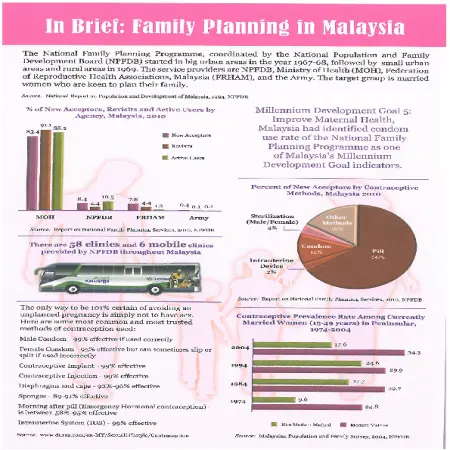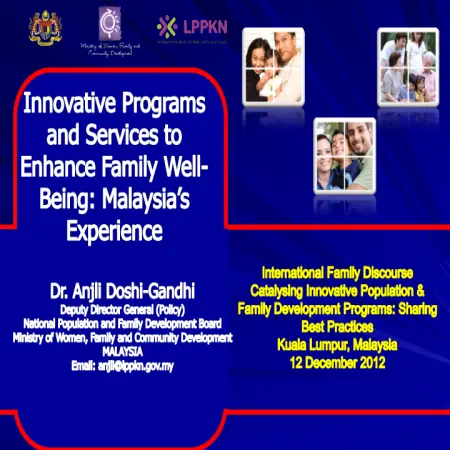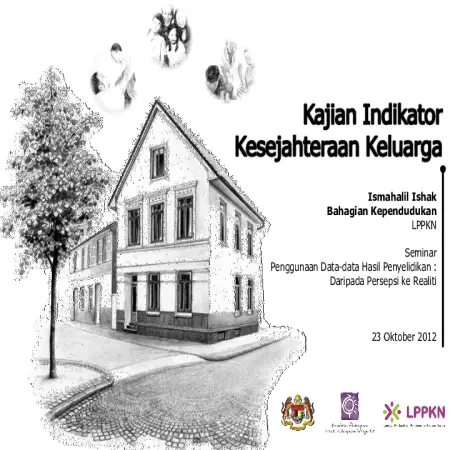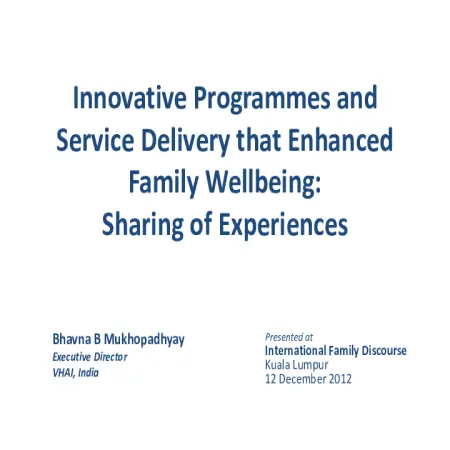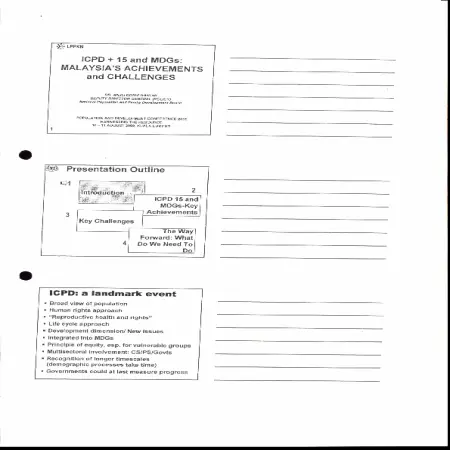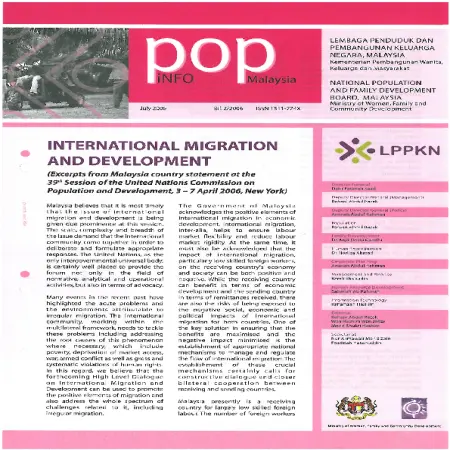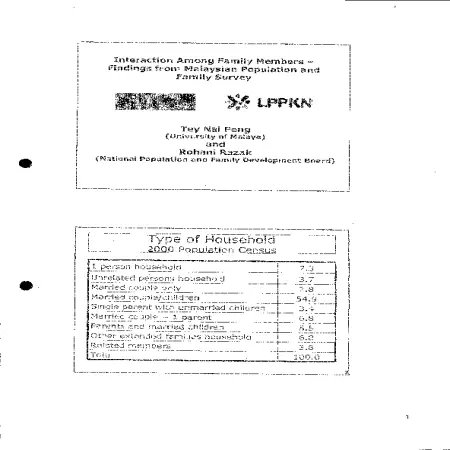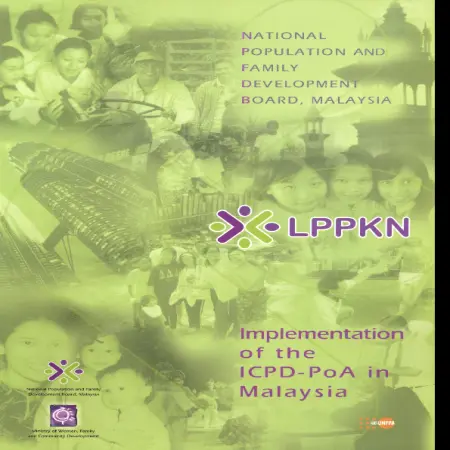Browse by Division/Agency
Results for Division/Agency : "LPPKN - National Population and Family Development Board, Malaysia: Population and Family Research Division"
|
|
Innovative programs and services to enhance family well-being: Malaysia's experience
Item Type: Conference or Workshop Item
Editor:
Year: 00/00/2012
Abstract: Families constantly face new pressures and challenges due to rapid Industrialisation, modernisation and globalisation. Globalization in general brings benefits to families but it also creates risks and challenges that must be anticipated and adapted to. Hence, we have to be alert and responsive to future challenges that families will face and equip them with the necessary knowledge, skills as well as provide the needed services. As family is the most fundamental and important social unit, commitments at the highest level should be sought. Family well-being in Malaysia has been affected positively or negatively by development. Currently, Malaysian families face many challenges as a consequence of the changes in its structure, the increase in the proportion of nuclear families and changing lifestyles. Adaptations will have to be made so as not to lose the family support system, such as for child care, care of the elderly and the infirmed. Hence, the 3P Approach (Public, Private and People) which involves the partnership of multiple stakeholders such as the government, civil society and CSOs in ensuring that the present and future generation is more peaceful, secure, tolerant, prosperous and sustainable is most paramount in nation building. There are various innovative initiatives that have been undertaken in strengthening the family institution such as the National Family Policy, 1Malaysia Family First (1MF1st) and 1 Malaysia Youth and Empowerment Support (1MYes) under the National Blue Ocean Strategy, Strengthening of Marriage Institution (SmartStart Pre-Marriage Program), 1 Stop Family Centre, family education programmes such as KASIH Modules, Parenting@Work, Smart Belanja@Lppkn, Lppkn@Community and counselling programmes. Realizing that the happiness of the people and wellbeing of the family is an important goal in becoming a high income country by 2020, the government is developing its own model of the United Nations World Happiness Index. Currently, Malaysia is placed 51st among 156 countries. Meanwhile, a National Family Wellbeing Index developed by the Ministry Of Women, Family and Community Development through the National Population and Family Development Board in 2011 found that the Family Wellbeing Index is 7.55 out of 10. The Family Well-Being (FWB) Index consists of seven domains; Family Functioning, Economy, Health, Safety, Community, Religion and Spirituality, and Housing and Environment. The FWB Index indicates that Malaysian families have a relatively high level of wellbeing but more still needs to be done.
|
|
|
|
|
|
Indikator kesejahteraan keluarga
Item Type: Conference or Workshop Item
Editor:
Year: 00/00/2012
Abstract: Family well-being is a multi-dimensional concept that covers various aspects of an individual or family's living situation. To date, there is no specific measure that can describe the state of family well -being in Malaysia. Thus, the Ministry of Women, Family and Community Development through the National Population and Family Development Board (LPPKN) and the International Islamic University of Malaysia (IIUM) has implemented a research project called the Study of Family Well -Being Indicators in 2011 to understand more comprehensively about family well -being where at the end of this project, an index will be developed. In total, after going through several formative processes such as literature review, focus group discussion and pilot study, there are 7 domains and 23 indicators have been identified. The development of such domains and indicators of family well-being has focused on subjective well-being where each family is asked to provide an assessment on certain aspects related to their family. The study was conducted on 2,808 households involving a total of 5,616 respondents, consisting of 1,484 fathers, 1,324 mothers and 2,808 adolescents aged between 13 to 24 years. The selection of households in this study has used stratified random sampling method and done by face -to -face interviews. The results show that the Family Well -Being Index is at 75.5 which means that the well -being of Malaysian families is quite high. The Family and Religion/Spirituality domain recorded the highest domain score of 82.5. This was followed by the domain scores Family and Community (78.3), Family Relationships (78.2), Family Safety (73.9), Family Health (73.8), Family and Environment (72.8) and Family Economics (69.0). Based on the results of the IKK study, some suggestions that can be taken into account to improve the level of family well -being are to improve family living standards, increase family resilience, balance work and family demands as well as increase awareness on family safety.
|
|
|
|
|
|
Innovative programmes and service delivery that enhanced family wellbeing: sharing of experiences
Item Type: Conference or Workshop Item
Editor:
Year: 00/00/2012
Abstract: While India has been on the path of economic progress over the last decade, our health system is at crossroads today. Even though Government initiatives in public health have recorded some noteworthy successes over time, the Indian health system is ranked 118 among 191 WHO member countries on overall health performance. There are wide variations in health indicators across the States (11 states with a population of 60%, still have a TFR of over 3 whereas 6 states with 11.4% of the population have already achieved replacement levels of fertility of 2.1. Some of the flagship programmes to improve the availability of and access to quality health care, especially for those residing in rural areas, the poor, women, and children, have been National Rural Health Mission (NRHM) and Mahatama Gandhi National Rural Employment Guarantee Act (MGNREGA). This paper discusses the sharing of information on the health system in India.
|
|
|
|
|
|
Income security systems in the Republic of Korea? Directions for development
Item Type: Conference or Workshop Item
Editor:
Year: 00/00/2012
Abstract: The four goals of public pensions - extension of coverage, provision of adequate benefits, an equitable share of costs between generations, and financial stability - are all important. However, as these four goals conflict and influence one another, it is difficult to attain them simultaneously. Therefore, it is necessary to compromise these goals at a certain level. National Pension in Korea has been developed within an astonishingly short period. However, coverage is still unsatisfactory and long-term financial state is unstable. These two issues seem to be the most urgent reform priorities. The former may be the most important issue because National Pension exists for the income security of people. Meanwhile, adequacy of benefit was partly relaxed through two reforms. Though long-term financial stability and equity between generations have been improved through some sacrifice of benefit level, these issues are still regarded as unresolved and need additional measures in Korea, one of the most rapidly ageing countries. In this paper, we examine the four major goals of National Pension, namely coverage, adequacy of benefit, inter-generational equity, and long-term financial stability. The coverage of the scheme should be extended and the average contribution period should be increased. Coverage must increase 10% by 2030 in terms of the ratio of old age pensioners to total old age people aged 65 and over. The benefit level of the National Pension may be targeted to 30% of average earnings in real term as of 2030. Other sources of old-age income can be from working, private pensions, and savings. For more stable finance and better equity between generations, we review four financial goals.
|
|
|
|
|
|
Indonesian labour migration to Sabah: causes and implications
Item Type: Conference or Workshop Item
Editor:
Year: 01/07/2011
Abstract: There is increasing interest among policymakers and researchers in the relationship between migration and development in low and middle income countries (United Nations, 2006). However, there remains a lack of empirical evidence on the impact of migration on economies of origin and destination, especially in Asia and Africa. This paper reports on one of the most substantial global migration corridors (World Bank, 2011) – that linking Indonesia and Malaysia. In 2009 it is estimated that migrants in Malaysia numbered 2 million, around a half of whom were Indonesians. It is based predominantly on a substantial survey of Indonesian labour migrants working in the East Malaysian state of Sabah undertaken in 2010. The paper begins with a brief discussion of contemporary thinking on the relationship between migration and development as a basis for examining the situation in Sabah. Some key features of the movement between Indonesia and Malaysia, especially that directed to Sabah, are then discussed. The economic contribution of Indonesian migrant workers is first examined in Sabah and then in the home areas of the Indonesian migrant workers. The paper then discusses the policy implications of these findings, especially in the Malaysian context.
|
|
|
|
|
|
ICPD + 15 and MDGS: Malaysia's achievement and challenges
Item Type: Conference or Workshop Item
Editor:
Year: 00/00/2009
Abstract: Population and development are inextricably linked. The ICPD helped place population concerns at the heart of sustainable development. Meeting the needs of women and men rather than on achieving demographic targets. Interrelationships between population, sustained economic growth and sustainable development: Population factors incorporated into development planning. Poverty alleviation programmes since the 1st OPP. This slides presentation is talk about ICPD + 15 and MDGS: Malaysia’s achievement and challenges.
|
|
|
|
|
|
International migration and development
Item Type: Newsletter
Editor:
Year: 00/07/2006
Abstract: The Government of Malaysia acknowledges the positive elements of international migration in economic development. International migration, inter-alia, helps to ensure labour market rigidity. At the same time, it must also be acknowledged that the impact of international migration, particularly low skilled foreign workers, on the receiving country's economy and society can be both positive and negative.
|
|
|
|
|
|
Interaction among family members: a Malaysian case study
Item Type: Conference or Workshop Item
Editor:
Year: 00/00/2006
Abstract: The perceived relationship among family members are 98.5% of women said that they have good family relationship while 99% of men said the same. Meanwhile, 99.3% of women who did not have financial difficulty stated that they have good family relationship compared to those who have financial difficulty represented by 98.3%.
|
|
|
|
|
|
Implementation of the ICPD-PoA in Malaysia
Item Type: Research Report
Editor:
Year: 00/00/2004
Abstract: The International Conference on Population and Development (ICPD) held in Cairo in 1994 was regarded as a landmark in the population and development field. At this conference,179 countries,including Malaysia,adopted a 20-year Programme of Action(PoA).The ICPD-PoA calls for empowering of women and providing them with more choices through access to education and health services and promoting skill development and employment.The PoA includes goals in regard to education, especially for girls, and for further reduction of infant, child and maternal mortality levels. It also addresses issues relating population;the environment and consumption patterns; the family; internal and international migration; prevention and control of the HIV/AIDS pandemic; information,education and communication;and research and development.This report assesses the progress made by Malaysia in the implementation of ICPD-PoA and in meeting the Millennium Development goals (MDGs). It provides a situational analysis of the population,development,reproductive health and gender related issues, and discusses the various policies and programmes implemented to achieve the objectives of ICPD-PoA. It also emerging challenges and opportunities and put forth some recommended strategies to further strengthen ICPD-PoA implementation in Malaysia.
|
|
|
|





